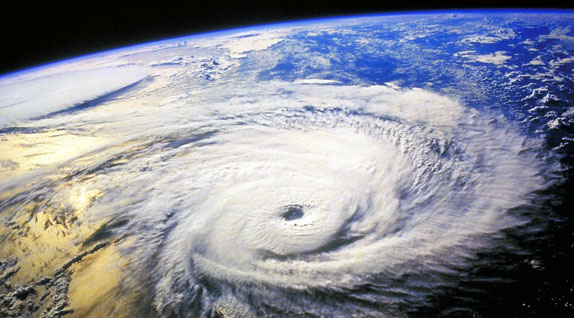 ArtToday, Inc.
ArtToday, Inc.
Article
Prominent in recent news, hurricanes have resulted in many lost lives and billions of dollars in damage. Why is this happening? There is a reason for this surge in activity, but most do not understand. Here is the answer!
Learn the why behind the headlines.
Subscribe to the Real Truth for FREE news and analysis.
Subscribe NowThe 2004 hurricane season in the United States has been proclaimed the worst since 1886. It was by far the busiest season for those who monitor and track tropical storms and hurricanes as they develop. This year alone, in a six-week period, four major hurricanes have pounded Florida and neighboring states.
The term “hurricane” refers to tropical cyclones. They are defined by the following criteria: They are generated in tropical areas of the ocean, close to the equator; their winds are cyclonic, meaning they swirl around a center eye; they have sustained winds of at least 74 mph; and they are low-pressure systems. Hurricanes usually form where there is warm water and moist air.
Most Atlantic Ocean hurricanes begin as thunderstorms off the west coast of Africa, and work their way over warm tropical oceans, increasing in strength. While in the Atlantic, these storms are carried toward Central and North America by easterly winds called trade winds.
These thunderstorms usually intensify through three phases: (1) tropical depression-wind speeds of less than 39 mph; (2) tropical storm-wind speeds increase to 39-73 mph; and (3) hurricane-winds over 73 mph. This intensification can take from a few hours to a few days.
Once formed, a hurricane has three main parts: (1) the calm, low-pressure center called the eye; (2) the area surrounding the eye, which has the most destructive winds, known as the eye wall; (3) the thunderclouds that circulate around the eye, referred to as rain bands.
From May 31 through December, hurricanes can form anywhere in the Caribbean Sea or Gulf of Mexico. However, the official Atlantic hurricane season begins June 1 and ends on November 30. About 99% of all cyclones occur during this period.
The effects of a hurricane include: heavy rain damage, inland flooding, storm surging, tornadoes and high-sustained winds. At a hurricane’s landfall, it is common to find 7 to 12 inches of rain on land, often far inland. This causes severe flooding and property damage-leading to destruction and death.
Storm surges are the most devastating effects of a hurricane. A storm surge is a wall of water that is pushed in front of a hurricane’s winds. If a surge occurs with a high tide, there is greatly increased inland flooding and beach erosion. Ninety percent of hurricane-related deaths are caused by flooding or water surge.
Although hurricanes have affected mankind for centuries, only within the past hundred years have experts been able to track their progress. The National Hurricane Center begins to track hurricanes in their infancy. While a storm is out at sea, its direction, strength and speed are monitored.
Though storms are quite unpredictable, this early tracking allows enough time for preparation and warning. A storm’s unpredictability is mainly attributed to a combination of trade winds and the jet stream. While trade winds mainly blow toward the west, the jet stream mainly moves toward the east.
Categories of Intensity
Warnings and estimates of potential property damage and expected flooding are determined according to the Saffir-Simpson Hurricane Scale. This scale rates hurricanes by wind speed, intensity, water gusts, storm surges and a few other factors. Notice the following categories and extent of damage:
• Category One: Wind speeds between 74-95 mph; storm surges 4-5 ft. above normal; some flooding and little to no structural damage.
• Category Two: Wind speeds about 96-115 mph; storm surges 6-8 ft. above normal; damage to doors, windows and roofs of structures and considerable damage to trees and shrubbery.
• Category Three: Wind speeds about 116-135 mph; storm surges 9-12 ft. above normal; structural damage to homes and buildings, mobile homes destroyed; severe flooding, large trees are blown down; evacuation of shoreline and low-lying areas; low-lying areas are cut off by flooding water 3-5 hours before the hurricane arrives.
• Category Four: Wind speeds about 136-155 mph; storm surges 13-18 ft. above normal; major structural damage to homes and buildings; complete uprooting of trees and shrubs; severe flooding and evacuations; mobile homes are completely destroyed.
• Category Five: Wind speeds exceeding 155 mph; storm surges at least 18 ft. above normal; some structures completely blown over; massive evacuation 5-10 miles from the shore; severe flooding, tornadoes are spawned, low-lying areas flooded 3-5 hours before the eye of the storm arrives; complete destruction of mobile homes, uprooted trees and shrubs, etc.
This Recent Season
The 2004 hurricane season has been one of the most intensive, damaging and destructive seasons on record. Florida citizens especially were advised to evacuate a number of times, often leaving in the face of one hurricane only to return to evacuate for the next. There has been more destruction in this one season than most people would see in a decade. The way these storms developed was almost like a prize fighter going in for a knockout-a right, a left, another right and then an uppercut!
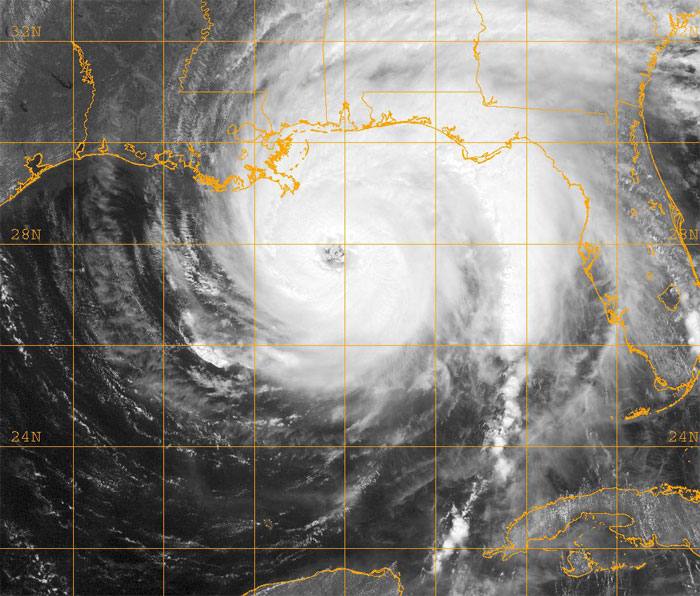 Naval Atlantic Meteorology and Oceanography Center
Naval Atlantic Meteorology and Oceanography CenterA report from the United Nations International Strategy for Disaster Reduction recently stated that, “Hurricanes, floods and other natural disasters hit a growing number of people worldwide and are on the increase...More than 254 million people were affected by natural hazards last year, a near three-fold jump from 1990, according to data released by the inter-agency secretariat...The random nature of disasters renders mapping their impact more difficult as droughts in 2002 pushed the figure of people affected above 734 million...Not only is the world globally facing more potential disasters, but increasing numbers of people are becoming vulnerable to hazards...An onslaught of deadly hurricanes that have battered the southern United States supported theories that such storms were occurring more frequently.”
The last time a single state was hit by four hurricanes in a year was in 1886 in Texas. This season, Florida has been attacked at its panhandle, at the southwest coast, up the center and across the middle.
Of course, the people of Florida are frustrated and tired of the constant onslaught of storms. There was not even enough time to clean up from one storm before another one came through.
The Names of Destruction
Alex was the first hurricane of the season. Although it did not strike Florida, Alex was stronger than expected when it hit North Carolina’s coast. High winds toppled trees onto power lines, cutting power to thousands. The eye of the storm barely passed Cape Hatteras. The strongest part (the eastern edge) of Alex remained at sea, sparing the area from even more damage.
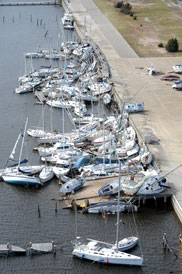 U.S. Navy
U.S. NavyOn August 13th, Charley, the first hurricane to hit Florida, came ashore just 70 miles south of Tampa, with sustained winds of 145 mph. An estimated 12,000 homes were damaged, resulting in thousands of insurance claims. Before slamming Florida, it passed Jamaica and Cuba. After reaching land, it continued on a northern path, causing even more flooding and destruction.
Frances, a Category Two hurricane, was slightly less powerful than Charley, but dropped more rain, causing at least $4 billion in damage. The total area of this storm as it went over Florida was the size of the entire state of Texas. An estimated 2.5 million people were evacuated in the days prior to its landfall.
Frances hit land north of Miami and crossed the state from east to west. It then went into the Gulf of Mexico, only to strike the Florida panhandle, leaving six million people without electricity.
Ivan looked to be one of the worst storms ever, with sustained winds of 165 mph. It slowly devastated the Caribbean, causing more than 100 deaths as it passed Tobago, Grenada, Venezuela, the Dominican Republic, Jamaica, Cuba and the Cayman Islands. It eventually made landfall near Mobile, Alabama as a Category Three hurricane. It pounded the Florida panhandle and three other states as it moved inland. It drove through the Appalachia region, causing flooding as it went.
But Ivan did not end there. This persistent storm turned back into the Atlantic Ocean, looped back to the Gulf of Mexico and lashed at Louisiana as it headed toward Texas as a tropical storm. Even the National Hurricane Center announced, “It sounds like the sequel to a very bad horror movie, but it’s no joke. Ivan is back.”
While Ivan was the strongest, Jeanne is the highest on the list for endurance. As Jeanne was approaching Florida, Governor Jeb Bush said, “I know people are frustrated. I know they are tired of all this. Trust me, their governor is as well.”
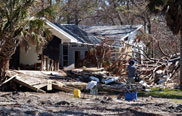 FEMA/Bill Koplitz
FEMA/Bill KoplitzJeanne hit Puerto Rico on September 15, reaching land the next day on the Dominican Republic and then moved on to Haiti. Hurricane winds extended 45 miles from the eye, with tropical storm winds reaching another 140 miles beyond that. In its aftermath, the death toll in Haiti was estimated at 1,600 people, with an estimated 250,000 to 300,000 left homeless.
After leaving Haiti, it looked as if Jeanne was going to head out into the Atlantic. Instead, she circled around, gained strength and zeroed in on Florida’s coast, making it the fourth hurricane in the season to hit the state. From the south end of the state to the Georgian border, up to three million people were urged to evacuate. Twenty-four-foot waves were moving ahead of Jeanne, along with a six-foot storm surge.
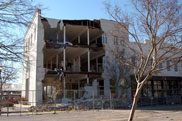 FEMA/Mark Wolfe
FEMA/Mark WolfeJeanne hit the coast of Florida at relatively the same place where Frances had hit only three weeks earlier. It came ashore as a powerful Category Three. Piles of debris not yet removed from the aftermath of Frances were thrown around like missiles, adding to the clean-up cost. Damage estimates from this storm alone are between $6 billion to $14 billion. And this reflects only those who had insurance! Most will remember the devastation that Hurricane Andrew caused in Florida over a decade ago, costing an estimated $26 billion. New building codes were enacted after Andrew, which may explain a lower monetary damage amount.
The loss of life from these four storms in Florida alone was 70 people. Thousands of others outside the United States lost their lives. To date, this is the costliest hurricane season ever in terms of dollars-and lost lives!
Why This Increase?
Why this sharp increase in hurricane activity? What is going on? What is wrong with our weather?
This increased hurricane activity has been linked to El Niño and La Niña. El Niño causes hurricanes in the Atlantic to decrease, but increase in other parts of the world. On the other hand, La Niña intensifies Atlantic hurricanes. Beginning in 1995, all but two Atlantic hurricane seasons (1997 and 2002, both El Niño years) have been above normal. In the 25-year period prior to this (1970-1994), the activity was below normal.
Global warming and other climate changes are major contributors to the increased effects of El Niño and La Niña. In turn, these effects are creating the conditions that can trigger what some scientists call “monster” storms.
Massachusetts Institute of Technology professor Kerry Emanuel estimated that oceans will become three degrees warmer due to global warming. This would increase hurricane winds and rains by 10%! The damage this would cause, on top of the already devastating effects of hurricanes, would be astronomical!
Violent Weather Prophesied
Christ warned that just before His Return, there would be an increase in violent weather. Storms such as hurricanes and other “natural” disasters would increase. Mount St. Helens in the state of Washington is ready to erupt for the second time in twenty-five years. The nations of China, India and Pakistan are losing hundreds of lives in unprecedented storms.
As the end of this age and the Return of Christ move closer, natural disasters are going to increase. God is going to “step up” disasters in order to get this world’s attention as it pursues its own course, ignoring the consequences. Not only are hurricanes increasing, but so are other disasters-earthquakes, tornadoes, floods, famines, wars and diseases.
In addition, man is continuing to deplete the earth’s natural resources. He is continuing to pollute the land, sea and air. And by doing so, he is upsetting the balance of nature and bringing about the disasters foretold in the Bible.
Mankind has entered the final countdown of social collapse, upset weather patterns and escalating fallout from ignoring cause and effect.
Blessings for Obedience
The modern descendants of ancient Israel-primarily the United States, Britain, Canada, New Zealand and Australia-have been greatly blessed by God. It is not the subject of this article to prove that the U.S. and Britain-and the other nations descended from Abraham, Isaac and Jacob (Israel)-are the recipients of those blessings. (You may learn more about this subject in our book America and Britain in Prophecy.) These blessings were a direct result of our forefather Abraham’s obedience to God almost 4,000 years ago. God gave His Word to Abraham, Isaac and Jacob-and then fulfilled that promise.
But those blessings are now being removed! The sun is setting on the greatness that God gave to modern Israel.
Punishment for Disobedience
God warned Israel centuries ago of what would happen if they disobeyed His Law. The nation would receive severe punishment unless it repented. Notice Leviticus 26:14-35:
“But if you will not hearken unto Me, and will not do all these commandments; and if you shall despise My statutes, or if your soul abhor My judgments, so that you will not do all My commandments, but that you break My covenant: I also will do this unto you...Then will I also walk contrary unto you, and will punish you yet seven times for your sins...Then I will walk contrary unto you also in fury; and I, even I, will chastise you seven times for your sins...And I will make your cities waste, and bring your sanctuaries unto desolation, and I will not smell the savor of your sweet odors. And I will bring the land into desolation: and your enemies which dwell therein shall be astonished at it...and your land shall be desolate, and your cities waste. Then shall the land enjoy her Sabbaths, as long as it lies desolate, and you be in your enemies’ land; even then shall the land rest, and enjoy her Sabbaths. As long as it lies desolate it shall rest; because it did not rest in your Sabbaths, when you dwelt upon it.”
These are strong words from God. But God does not say this in vain. The nations that have descended from ancient Israel have forgotten God and have sinned against Him. God will do what He says He will do-and this will happen very soon. Just as God fulfilled His promise to bless Israel, He will also fulfill His promise to punish Israel-unless these nations repent!
There Is Hope For Mankind!
Just as meteorologists are able to locate and track storms that form over the sea and predict when and where they will hit land, the signs of Christ’s Return are also here. Speaking of the time shortly before His Return, Christ said, “But of that day and hour knows no man, no, not the angels of heaven, but My Father only” (Matt. 24:36). Although we cannot know exactly when Christ will return, notice what He said just four verses earlier: “Now learn a parable of the fig tree; when his branch is yet tender, and puts forth leaves, you know that summer is near: so likewise you, when you shall see all these things, know that it is near, even at the doors. Verily I say unto you, this generation shall not pass, till all these things be fulfilled” (Matt. 24:32-34).
These signs show that Christ will return soon and establish His Government on this earth. Only then will this world be healed. People will learn how to live in peace, harmony and prosperity-with perfect weather.
More on Related Topics:
- The Swarm of Earthquakes Shaking Santorini Prompts Greece to Declare an Emergency
- Nearly 250 Million Children Missed School Last Year Because of Extreme Weather, UNICEF Says
- What to Know About the Devastation from the Los Angeles-area Fires
- Los Angeles Wildfires Rage Out of Control, Testing Firefighting Resources
- A Quarter of Freshwater Animals Are Threatened with Extinction, New Research Shows



